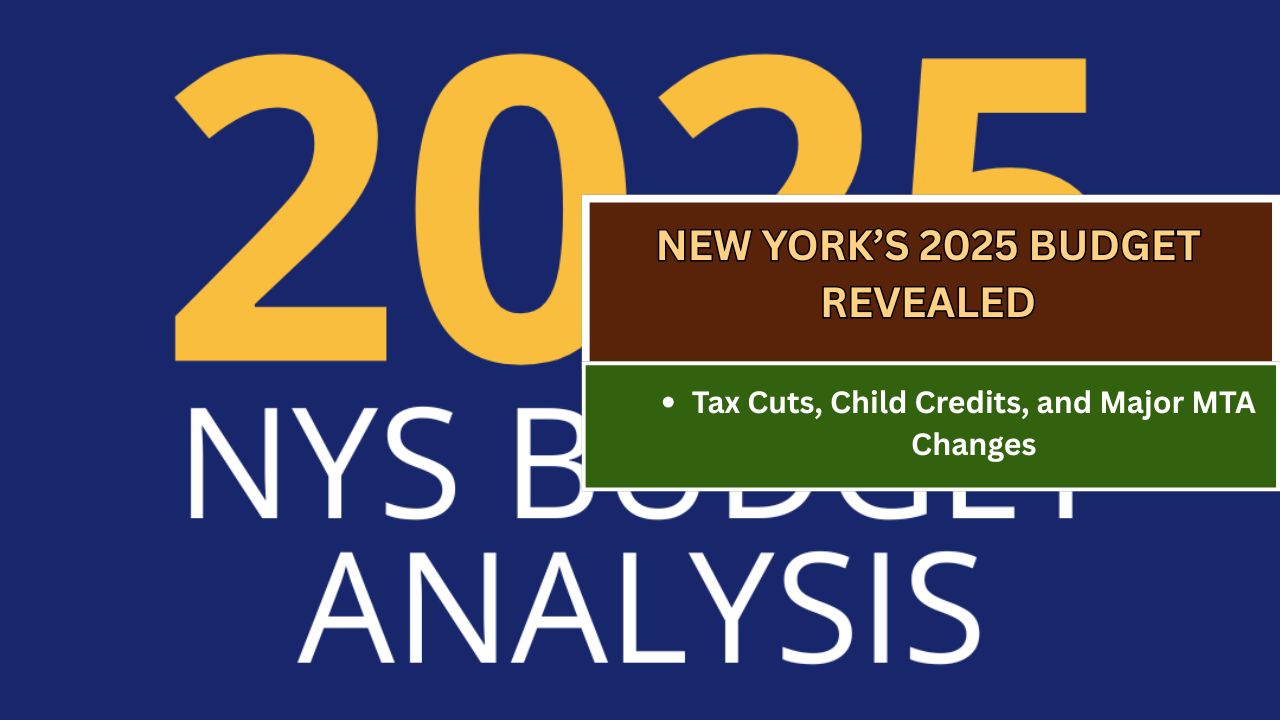ALBANY, N.Y. — Nearly four months after Governor Kathy Hochul introduced her proposed budget, lawmakers passed a final $254 billion plan—the largest in the state’s history. They had only a few days to review the massive document, packed with financial decisions that impact millions of New Yorkers.
This final version came in slightly higher than Hochul’s January proposal but still a few billion dollars less than what the Senate and Assembly initially suggested.
The budget keeps personal income tax rates steady but raises taxes on large businesses in New York City to support the MTA’s expansive capital improvements. Middle-income families will benefit from minor tax reductions, and parents with children under four will see an increase in the child tax credit. Additionally, most residents will receive a one-time inflation rebate between $150 and $400.
Two of the most controversial issues—reversing discovery reforms and expanding involuntary mental health commitment—passed, along with a new restriction on wearing masks in public.
The budget steers clear of deep cuts to social services, likely avoiding problems if federal funding is reduced under President Donald Trump. New York will use $8 billion from its reserve funds to stabilize the unemployment insurance system. Parents can expect a higher child tax credit.
However, several proposals didn’t make the cut. Lawmakers excluded plans for cap and invest, the NY HEAT Act, a solar tax credit expansion, zoning reform, and financial assistance for first-time homebuyers.
Budget negotiations in Albany are often closed-door, and this year’s process was no different. State Senator James Skoufis criticized the governor, saying she steamrolled the legislature, reducing its role to making suggestions. Still, lawmakers gave Hochul the power to make budget cuts if federal funds are withdrawn.
Because of the delay, legislators now have just 18 days left this year to handle everything else.
Fiscal Policy
Total state spending is set at $254 billion, falling between Hochul’s smaller original proposal and the larger figures pitched by lawmakers.
Although personal income taxes aren’t going up, large employers in New York City with annual payrolls over $10 million will face new taxes to fund the MTA.
Households earning less than $323,000 will see a 0.2 percent tax cut, a promise Hochul made in her affordability plan. However, reports show that the wealthiest 20 percent of taxpayers will benefit the most from this cut.
To help offset inflation, most New Yorkers will receive rebate checks ranging from $150 to $400. Critics from both sides argue the rebates offer only short-term relief while costing the state billions.
New York will use $8 billion from its savings to repay pandemic-era federal loans tied to unemployment insurance. It will also bolster the unemployment fund to keep it solvent. After this, reserves are expected to fall to about $23.4 billion, though exact figures aren’t available yet.
The MTA needs $68 billion for its five-year infrastructure plan. Much of the funding will come from tax hikes on large businesses and a mix of city, state, and federal funds. However, if the Trump administration follows through on threats to cut federal funding over congestion pricing disputes, the MTA could face serious challenges.
Family Policy
Child care workers, who received bonuses over the past two years from federal funds, will not receive state bonuses this year. Low pay continues to drive shortages, impacting availability and increasing costs for families.
To help close a major funding gap, the state will contribute $350 million to New York City’s child care voucher program, but only if the city matches that amount. If it doesn’t, the funds will go to other counties. An additional $50 million will support similar programs across the state without requiring matching funds.
A new $3 million initiative will fund a registry of substitute child care workers to help providers cover sick days without disrupting service.
Families with children under four will see their maximum child tax credit triple from $330 to $1,000 per child. Starting next year, families with children aged four to 16 will see their credit increase to $500.
Parents on public assistance will receive a $1,800 allowance upon the birth of a child, marking a first-of-its-kind benefit in the nation.
Social Services
New York will use $8 billion of its reserves to eliminate unemployment insurance debt and raise the weekly maximum benefit from $504 to $869—the first increase in six years. Employers will also pay payroll taxes on a slightly larger portion of wages. However, some economists warn these changes may not be enough to prevent future debt.
Nonprofits that provide essential services will receive a 2.6 percent funding increase. The funds are earmarked for hiring and retaining support staff rather than boosting executive salaries.
The long-neglected New York State Supportive Housing Program will receive $71.4 million, allowing for higher reimbursement rates and critical repairs.
Despite hopes for a $200 million expansion, the Energy Affordability Program did not receive any additional funds in the final budget.
The budget does include $53 million for in-home services for seniors who aren’t eligible for Medicaid, which AARP hailed as a big win.
Housing
Major zoning reforms were left out. Suburban lawmakers resisted changes that would make it easier to build new housing.
A proposed $50 million program to help first-time homebuyers afford mortgages didn’t make it into the final budget, despite early support from both legislative chambers.
A new rule bans private equity firms from purchasing single- or two-family homes until they’ve been listed for at least 90 days. It also blocks them from accessing certain tax benefits, aiming to reduce competition and lower prices for everyday buyers.
A proposed ban on rent-setting software was removed after both houses rejected it. Advocates plan to revisit the issue later this session.
The budget allocates $50 million for low-interest loans to developers who include affordable housing in new projects outside New York City. These loans will be recycled as developers repay them.
Another $50 million will launch a new voucher program to help homeless individuals and those at risk of losing their homes. While advocates initially asked for $250 million, they consider this a step forward.
Criminal Justice
Governor Hochul pushed to scale back discovery reforms, which dictate how prosecutors share evidence with defense attorneys. Though the legislature resisted major changes, she secured limited revisions. The final language is less sweeping than her administration initially claimed.
A revised involuntary commitment law passed, allowing police to hospitalize individuals unable to meet basic needs like food or shelter. However, only ambulances—not police—can transport these individuals, and hospitals must offer post-release support.
New York will close up to three prisons in the next year. Hochul had initially proposed up to five closures to address staffing issues.
The budget expands the role of the State Commission of Correction, requiring it to inspect every jail and prison annually.
Correctional officers must now wear body cameras and keep them on at all times while on duty.
Climate
For the first time, New York will allocate $1 billion from its general budget to combat climate change. Half of that will fund thermal energy networks to electrify heating and cooling. Another $250 million will help local governments and businesses adopt electric vehicles. About $200 million will support grid upgrades and public renewable energy projects. The remaining $100 million is reserved for flexible spending under Hochul’s oversight.
Advocates celebrated wins like the funding for thermal networks but criticized the absence of the cap and invest program, which is now tied up in court.
The NY HEAT Act was again excluded, despite support from the Senate and climate groups.
The state will dedicate $500 million to drinking water improvements, continuing a seven-year streak of clean water investments.
The Environmental Protection Fund will grow slightly to $425 million, a new record, though still short of what lawmakers had hoped.
Efforts to increase the solar tax credit to $10,000 didn’t make it into the final plan. However, geothermal heating tax credits were expanded and made refundable. Advocates hope solar reforms will still pass later this year.
New York will create a $2 million Green Pre-Electrification Fund to help low-income homeowners fix issues like mold or lead that prevent energy-efficient upgrades.
Education
The state will spend about $36 billion on education, including $26.4 billion in Foundation Aid. The aid formula received its first major update since 2007, adjusting for poverty and adding funds for English Language Learners.
All students in New York will now have access to free breakfast and lunch through a new universal school meals program.
The Opportunity Promise Scholarship will offer free community college to adults aged 25 to 55 pursuing high-demand careers in areas like nursing, cybersecurity, and teaching.
CUNY will receive $6.6 billion, while SUNY will get $15.7 billion. Both figures are in line with Hochul’s earlier proposals, although the Senate had called for significantly more funding, particularly for capital projects.
This article has been carefully fact-checked by our editorial team to ensure accuracy and eliminate any misleading information. We are committed to maintaining the highest standards of integrity in our content.

Vikas Lalit is an experienced content writer at OTE News, covering business, economy, and international affairs. With a degree in Journalism, he combines analytical thinking with engaging storytelling to deliver well-researched updates. Vikas is passionate about uncovering underreported stories that impact readers.
Outside of work, he enjoys playing chess, following cricket, and writing short stories. His commitment to integrity and in-depth analysis strengthens OTE News’ mission of providing trustworthy journalism.




